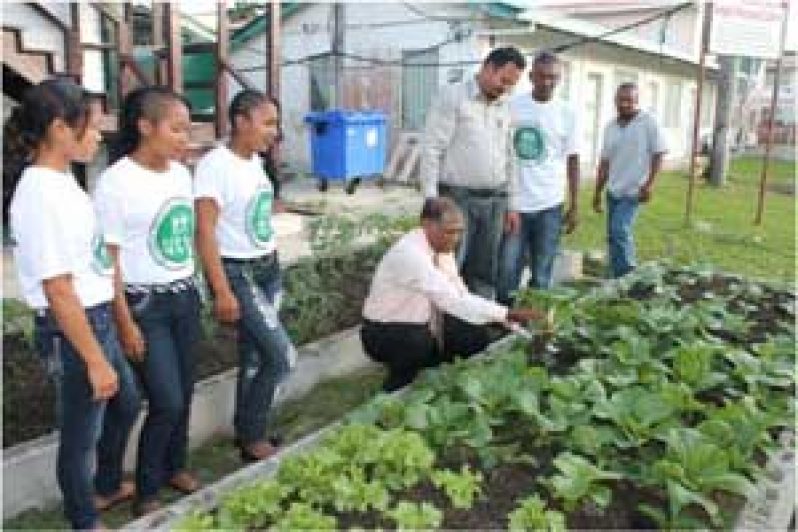SAFE-GUARDING Guyana’s food security was one of the milestones for achievements in the agriculture sector for 2012 and this effort was consolidated with the acknowledgement that the sector is already a mainstay in Guyana’s development. The sector focused on preserving and strengthening food security, reducing food imports, developing value-added (agro-processing) industry, developing an agro-fuel industry and creating employment and generating wealth.
 Agriculture contributes almost 23% of the economy, accounts for more than 33% of employment and about 50% of Guyana’s export earnings come from the sector.
Agriculture contributes almost 23% of the economy, accounts for more than 33% of employment and about 50% of Guyana’s export earnings come from the sector.
Food security
Minister of Agriculture, Dr. Leslie Ramsammy has acknowledged that Guyana is a food secure country as such the aim is to ensure that not only is food security preserved, but that status as well. The agriculture sector acknowledges that the taste in food varieties, by Guyanese, has impacted the food import bill which is US$225 per capita. Nevertheless that is slated to change with the implementation of projects like the Jagdeo initiative which was introduced to the Guyanese business and farming communities at GUYEXPO 2012.
The achievement of food security was the basis on which the 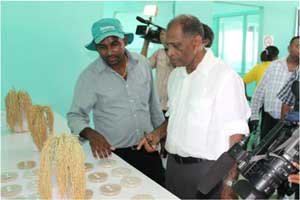 Jagdeo Initiative, a regional programme, was conceptualised by former President Bharrat Jagdeo who was responsible for agriculture in the Caribbean Community (Caricom). The initiative identifies and defines nine key, critical and binding constraints to the development of the agriculture sector in the Caribbean region and practical interventions at the regional and national levels to alleviate those constraints.
Jagdeo Initiative, a regional programme, was conceptualised by former President Bharrat Jagdeo who was responsible for agriculture in the Caribbean Community (Caricom). The initiative identifies and defines nine key, critical and binding constraints to the development of the agriculture sector in the Caribbean region and practical interventions at the regional and national levels to alleviate those constraints.
The ‘new agriculture vision’ aims at making the sector more than food production by exploring the numerous opportunities that exist for agro-businesses which will create more employment, increase export earnings and the income of all stakeholders, especially farmers.
Historic rice production
T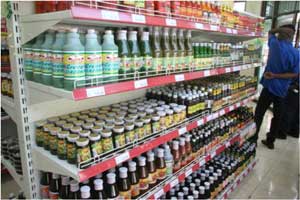 he local rice industry continued to stand in the face of the negative global economic changes to shoulder food security, gain export strength, and provide steady employment opportunities for Guyanese.
he local rice industry continued to stand in the face of the negative global economic changes to shoulder food security, gain export strength, and provide steady employment opportunities for Guyanese.
At the beginning of 2012, the rice production target was set at 412,000 tonnes, and at the close of the year, the Agriculture Ministry reported that as of December 18, production figures were at 420,000 tonnes, by far, the largest output in the history of rice production in Guyana. This tremendous increase in output surpassed the 2011 production of 402,000 tonnes.
The rice sector has also done exceptionally well in export as well with more than 300,000 tonnes of rice sold to other countries. The rice export earning now stands at US$176M and has the potential to increase by US$20M by the end of December 2012. Over the la st three years, Venezuela has been the major export market for Guyana’s paddy and rice, accounting for approximately 60% of total export. While this is a very good trade for the country, the Ministry of Agriculture intends to continue rice exports to traditional markets in Europe and CARICOM countries like, Jamaica and Trinidad.
st three years, Venezuela has been the major export market for Guyana’s paddy and rice, accounting for approximately 60% of total export. While this is a very good trade for the country, the Ministry of Agriculture intends to continue rice exports to traditional markets in Europe and CARICOM countries like, Jamaica and Trinidad.
Claiming yet another major accomplishment for 2012, the Agriculture Ministry announced that Guyana’s first aromatic line of rice was successfully cultivated on 60 acres of land; moving from experimental conditions to actual field conditions.
The aromatic rice is expected to be tested across the country during 2013, with the expectation that at least 25 farmers will undertake the first commercial production of the rice. This success 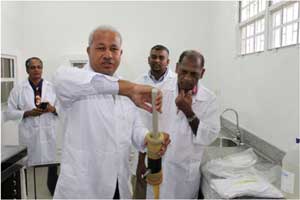 can be credited to dedication of the Ministry of Agriculture and the Guyana Rice Development Board’s (GRDB) research programme.
can be credited to dedication of the Ministry of Agriculture and the Guyana Rice Development Board’s (GRDB) research programme.
The production of an aromatic line of rice will allow the rice industry an opportunity to compete in niche markets, locally and internationally especially since aromatic brands such as India’s Basmattie ice are premium products with high prices.
With the commissioning of the seed facilities it is expected that Guyana will generate more than 20,000 bags of seed paddy for farmers by the second crop of 2013. The Burma Seed Paddy Facility produces about 10,000 bags per crop and together with the Rice Producers Association (RPA) and private rice farmers; the industry produces about 180,000 bags of seed paddy annually for 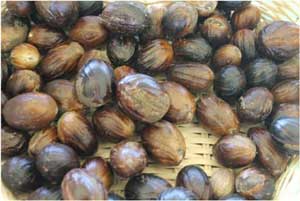 use in the industry.
use in the industry.
Steps to boost rice cultivation in the hinterland is also moving apace particularly in Region 9.
Meanwhile farmers of Regions 3, 4, 5 and 6 were able to participate in several Farmers’ Exchange Programme hosted by the Guyana Rice Development Board in collaboration with the RPA.
The Guyana Shop was commissioned in October 2012 to further boost the promotion and distribution of agro-processed products and is a means of launching entrepreneurs into larger markets.
While there was a reduction in locally produced items, the demand did not reduce since many Guyanese supermarkets indicated increased sales of locally made products. This is evident in the fact that despite the Guyana Shop opened recently, the December sales amounted to about $5M.
Infrastructure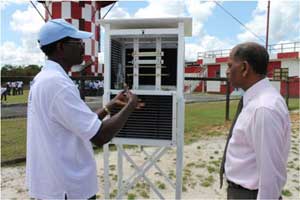 A number of infrastructure improvements occurred in 2012 such as the completion of a new rice seed facility at Number 56 Village, commissioning of the Artificial Insemination Laboratory, procurement of six new mobile and eight fixed site pumps which are to be delivered early 2013, procurement of new equipment for improved animal health and the completion of design for a new Animal Health Lab, progress of Hope Canal, completion of a new sluice at Bengal and a pump station and canal for Canal Polder Number 2 Polder, design for new agriculture scheme at Aurora, and the installation of two geo-textile breakwater tubes at Victoria.
A number of infrastructure improvements occurred in 2012 such as the completion of a new rice seed facility at Number 56 Village, commissioning of the Artificial Insemination Laboratory, procurement of six new mobile and eight fixed site pumps which are to be delivered early 2013, procurement of new equipment for improved animal health and the completion of design for a new Animal Health Lab, progress of Hope Canal, completion of a new sluice at Bengal and a pump station and canal for Canal Polder Number 2 Polder, design for new agriculture scheme at Aurora, and the installation of two geo-textile breakwater tubes at Victoria.
D&I
In meeting its mandate the National Drainage and Irrigation Authority (NDIA) had an active year in 2012 with some notable achievements including improving and upgrading drainage and irrigation services countywide, thereby enhancing the competitiveness of the various sectors and improving productivity.
The Government of Guyana through the Japan Cooperation Agency received eight long reach excavators and two pontoons as part of component one of the rehabilitation of the East Demerara Water Conservancy (EDWC). The agreement is a two-part project with an estimated cost of US$7.4M.
Sluices were constructed at Waterloo, Noitegadact in Region 3, Grove/Diamond in Region 4, Profitt, Abary which is 60% completed, Retrieve and Cottage, Mahaicony in Region 5 and at Mara and Bengal (70%), Region 6. At Bengal a pump station is also being constructed.
All improved and rehabilitated sluices are now serving areas to withstand in excess of 2.5” of rainfall in 24 hrs as compared to the 1.5” in 24 hrs before.
As part of the move to ensure that Guyana remains flood resilient, the Ministry of Agriculture procured a $57M pontoon that was constructed by Courtney Benn Contracting Services and that is earmarked for Region 2.
Livestock
In 2012, the livestock industry continued to play a significant role in furthering Guyana’s economic and social development with its contribution of more than US$ 58M to the GDP.
Genetic improvement is an important strategy being used to increase meat yield and produce other products used in the food and other industries. The Genetic Improvement Unit is tasked with ensuring better breeds of animals are used to produce more and healthier meat and milk.
This year the unit produced 77,000 genetically improved ducklings while it contributed to the expansion of the largest Texana production in the country which made available breeding ewes, rams and most of all prime lambs in supermarkets. The Texana line was achieved through the use of the Texile line from England and the Black Belly from Barbados.
They also spearheaded and coordinated the increase in flock size of the main Boer goat farm located at Kibilibiri in the intermediate savannah from 500 to 700 goats and continued distribution of breeding bucks (Boer Goat) from registered pilot farmers to small ruminant farmers country wide.
Additionally, 33 beef bulls were imported, 19 of which were distributed to realise the objectives of the genetic improvement programme, while 548 calves were produced from Artificial Insemination, and processing began for the procurement of 66 female cows (heifers) from the USA.
Diversification
Diversification in spice cultivation, especially in the hinterland communities continued to be given prominence. This programme seeks to reduce the imports of spices such as turmeric, ginger, black pepper and nutmeg.
There are currently about 50 acres of turmeric, 100 acres of ginger, 5 acres of black pepper and 1 acre of nutmeg, principally in Region 1. It is anticipated that a processing facility for turmeric would be established in that Region.
The coconut sector has been given special attention. In 2009, the Ministry of Agriculture identified the sector for further development and a programme was developed for the revitalisation of the industry.
From data garnered, the weekly demand for water nuts is 100,000 with the annual production being about 240,000,000 nuts. This has the potential to be increased by at least 20-25% with improved technologies.
The industry will be further reviewed when a stakeholder’s meeting convened in January 2013.
Fish
The fishing industry continues to grow in economic importance and provides employment for many persons in the rural areas. It also ensures that the population remains among the highest per capita consumption of fish and fish products within the region. However, there is increasing pressure on the marine resources as such, measures are being taken to ensure that the fishing industry remains sustainable.
Aquaculture production for the period January to November 2012 was approximately 239 metric tonnes, a slight increase from last year’s figures. Marine production figures for the same period indicate production of approximately 47,000 metric tonnes, already surpassing 2011’s figures.
While the fishing industry continues to advance, it faces severe challenges from the continuing piracy attacks.
Training opportunities
During Agriculture Month in October, the ministry held a seminar that attracted hundreds of students from schools in Regions, 2, 3, 4, 5 and 6. This annual event paves the way for students to be exposed to agricultural technologies, and areas where they can tap into as career opportunities.
Agricultural policies, role of youth in agricultural development and the importance of research and extension were also highlighted.
As Guyana’s energy profile continues to be heightened, emphasis is being placed on building the capacity of personnel and in this regard a two- week training was held with focus on bio-energy.
The programme forms part of an overall multi-agency approach involving the Ministry of Agriculture, Institute of Applied Science and Technology (IAST), National Agriculture Research and Extension Institute (NAREI), and the University of Guyana to enhance and develop the country’s agro-energy sector.
One hundred and eleven students graduated from the Guyana School of Agriculture (GSA) at its 48th convocation. The students successfully completed programmes at GSA institutions in the Diploma in Agriculture, Diploma in Animal Health and Veterinary Public Health, Certificate in Agriculture, Certificate in Fisheries, and Certificate in Forestry.
Weather
Guyana, like Small Island Developing States faces the effects of climate change and has realised the increasing need for an efficient hydro-meteorological operating centre and, multi-hazard early warning systems which are important tools in disaster risk reduction management.
The Hydrometeorological Service continued to play an important role in Guyana, particularly in the agriculture and aviation industry. The Ministry of Agriculture has placed specific focus on improving the Service’s meteorology and technology base.
The Hydromet Service provided weather and climate forecast for aviation activities, agricultural planning and decision making and general public awareness.
Five Automatic Weather Stations were installed in 2012 – Abary Copeman, Mahaicony River, Orealla, Leonora Corner and Dawa. Five more will be installed soon.




.png)


